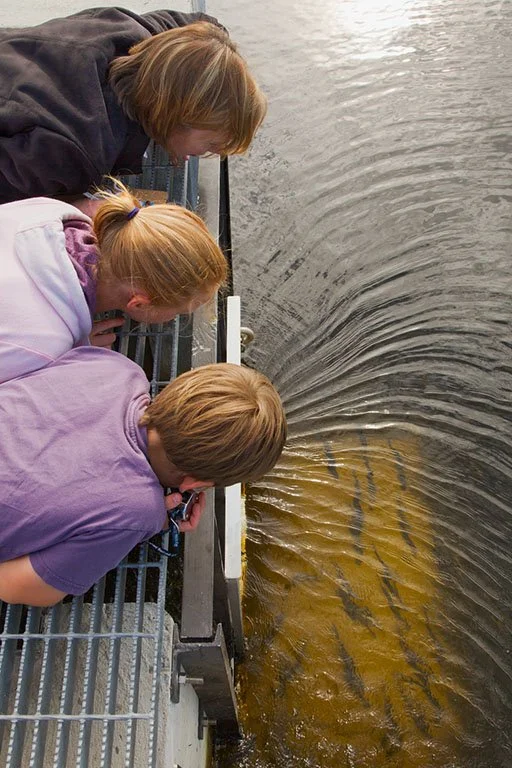By: Sue Denham
March 21 may indeed mark the vernal – or spring – equinox here in the northern hemisphere, but spring feels very distant indeed when, on an early, chilly April morning, you’re lying prone on the dam that marks the boundary between the Upper and Lower Mystic lakes and gazing into the dark waters. What are we doing? Why do we do it? And who, exactly, are “we”?
A volunteer herring monitor watching the migration at Mystic Lakes Dam. Photo Credit: MyRWA Archives
“We” are the dedicated team of keen volunteers who help the Mystic River Watershed Association track the alewife herring migration. This annual event sees more than half a million adult alewives swim from the coastal waters of the Western North Atlantic Ocean, through Boston Harbor, and up the Mystic River to spawn in the waters of their birth. Alewives are anadromous fish, which means they have the remarkable ability to thrive in both salt and freshwater; they live most of their adult lives in the ocean and return to freshwater to spawn. In the Mystic River Watershed, one of those freshwater destinations is Woburn’s Horn Pond. The three-month alewife migration up the Mystic River is only one of many coastal rivers along the Eastern seaboard— here in Massachusetts, alewives also migrate from the ocean to the Charles, Merrimack, Herring and other smaller rivers.
So much for the facts.
As I lie on the Mystic Lakes dam at the top of the fish ladder and gaze into the waters of the Upper Mystic, I wonder whether I’ll see 200 alewives or none in my 10-minute monitoring session. As the MyRWA folks tell us, even seeing no alewives during a session provides valuable data to track trends, something that data scientists know all too well.
Underwater image of herring migrating. Photo Credit: Patrick Herron
Just as I’m resigned to a quiet morning on the dam, suddenly, a small school of sleek alewives has fought against the ladder’s swift current and reached the top. I find myself holding my breath as each herring struggles against the current flowing between the lakes, silently cheering as they spill free into the calmer waters of the upper lake. It’s difficult to describe the feeling – it’s hard not to use the word “mystical”, for that’s exactly what it is – as I watch those first silvery herring of the season swim free on their way to their Horn Pond spawning grounds. They have come so very far! As they pass across the monitoring panel, I clutch a tally counter and my finger clicks frantically away. I’m eager to make an accurate count.
That small burst of alewives swimming home is all I’ll see this chilly morning. My monitoring session concluded, I remain on the dam, watching the morning unfold around me. It’s a still morning and the sun glints off the water; on brisk mornings the whitecaps — “whitehorses”, my British friend calls them – dance on the lake. I think about the May mornings to come when our New England landscape will be bursting with spring and warming breezes will waft gently across the water. Today, the bird watchers are out with their impressive lenses, focusing on the pair of bald eagles that nest in a tall pine overlooking the Lower Mystic or catching sight of the great blue herons that stalk fish and frogs along the shore.
Great Blue Heron at Mystic Lakes. Photo Credit: DFitcher
“The world is too much with us….little we see in nature that is ours. For this, for everything, we are out of tune; it moves us not.”
I reflect on these words by poet William Wordsworth. These quiet and contemplative mornings as I witness one of the world’s great migrations remind me that we need to seek moments that expose us to the nature happening around us. We are so very busy, in Wordsworth’s words, “getting and spending.”
The springtime mornings counting alewives on the Mystic or at Horn Pond provide anyone with just a few minutes to spare with the most modest – but oh so meaningful! – of opportunities to contribute to the effort that has transformed the Mystic Watershed into a recovering landscape and ecosystem. Participating in this great migration — truly one of nature’s grand events — is a life affirming experience and one that’s happening in our own backyard. If only we take the time to look.
A family viewing a school of herring at Mystic Lakes Dam. Photo Credit: David Mussina









